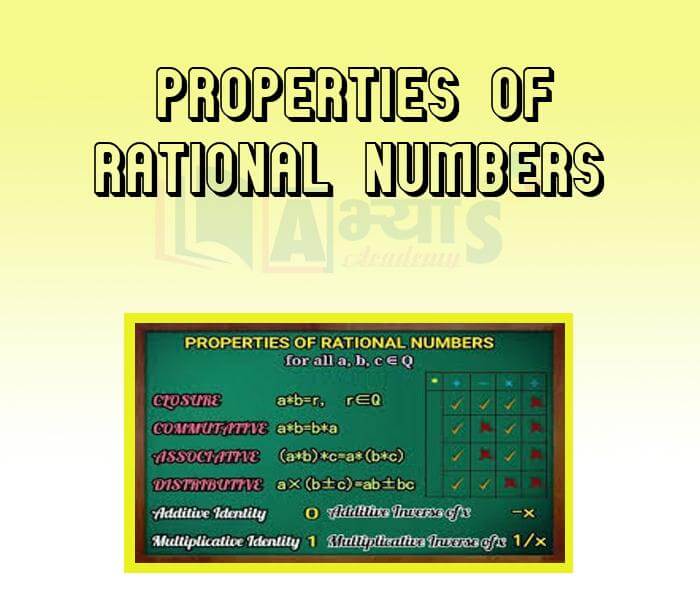Properties of Rational Numbers








Properties of Rational Numbers
Properties of rational numbers are closure property, commutative property and associative property. All these properties have been discussed earlier. Let us briefly describe these properties on the four binary operations (Addition, subtraction, multiplication and division) in mathematics.
Addition
2/9 + (4/9 + 1/9) = 2/9 + 5/9 = 7/9
(2/9 + 4/9) + 1/9 = 6/9 + 1/9 = 7/9
So, 2/9 + (4/9 + 1/9) = (2/9 + 4/9) + 1/9
Subtraction
And, 2/9 - (4/9 - 1/9) ≠ (2/9 - 4/9) - 1/9 . Therefore, Associative property is not true for subtraction.
Multiplication
So, 5/9 x 2/9 = 2/9 x 5/9. Therefore, Commutative property is true for multiplication.
2/9 x (4/9 x 1/9) = 2/9 x 4/81 = 8/729
(2/9 x 4/9) x 1/9 = 8/81 x 1/9 = 8/729
So, 2/9 x (4/9 x 1/9) = (2/9 x 4/9) x 1/9. Therefore, Associative property is true for multiplication.
Division
Distributive Property
1/3 x (2/5 + 1/5) = 1/3 x 3/5 = 1/5 -----(1)
1/3 x 2/5 + 1/3 x 1/5 = 2/15 + 1/15 = (2 + 1)/15 = 3/15 = 1/5 -----(2)
From (1) and (2), 1/3 x (2/5 + 1/5) = 1/3 x 2/5 + 1/3 x 1/5
Therefore, Multiplication is distributive over addition.
1/3 x (2/5 - 1/5) = 1/3 x 1/5 = 1/15 ------- (3)
1/3 x 2/5 - 1/3 x 1/5 = 2/15 - 1/15 = (2 - 1)/15 = 1/15 -----(4)
From (3) and (4),
1/3 x (2/5 - 1/5) = 1/3 x 2/5 - 1/3 x 1/5
Therefore, Multiplication is distributive over subtraction.
Which of the following is example of the Associative Property of Multiplication? | |||
| Right Option : C | |||
| View Explanation | |||
Mohan rearranged an expression to make it easier to solve. He changed 1/2 + (2/3 + 1/5) to (1/2 + 2/3) + 1/5. Which of the following properties tells us that it is okay for Mohan to arrange the problem that way? Also simplify the expression. | |||
| Right Option : A | |||
| View Explanation | |||
1/9 x (1/3 x 1/2) = (1/9 x 1/3) x 1/2 , is explained by which property? | |||
| Right Option : A | |||
| View Explanation | |||
Students / Parents Reviews [10]
One of the best institutes to develope a child interest in studies.Provides SST and English knowledge also unlike other institutes. Teachers are co operative and friendly online tests andPPT develope practical knowledge also.

Aman Kumar Shrivastava
10thIt was good as the experience because as we had come here we had been improved in a such envirnment created here.Extra is taught which is beneficial for future.

Eshan Arora
8thBeing a parent, I saw my daughter improvement in her studies by seeing a good result in all day to day compititive exam TMO, NSO, IEO etc and as well as studies. I have got a fruitful result from my daughter.

Prisha Gupta
8thAbhyas Methodology is very good. It is based on according to student and each child manages accordingly to its properly. Methodology has improved the abilities of students to shine them in future.

Manish Kumar
10thMy experience with Abhyas academy is very good. I did not think that my every subject coming here will be so strong. The main thing is that the online tests had made me learn here more things.

Hiya Gupta
8thAbout Abhyas metholodology the teachers are very nice and hardworking toward students.The Centre Head Mrs Anu Sethi is also a brilliant teacher.Abhyas has taught me how to overcome problems and has always taken my doubts and suppoeted me.

Shreya Shrivastava
8thMy experience was very good with Abhyas academy. I am studying here from 6th class and I am satisfied by its results in my life. I improved a lot here ahead of school syllabus.

Ayan Ghosh
8thIt was a good experience with Abhyas Academy. I even faced problems in starting but slowly and steadily overcomed. Especially reasoning classes helped me a lot.

Cheshta
10thIt has a great methodology. Students here can get analysis to their test quickly.We can learn easily through PPTs and the testing methods are good. We know that where we have to practice

Barkha Arora
10thMy experience with Abhyas is very good. I have learnt many things here like vedic maths and reasoning also. Teachers here first take our doubts and then there are assignments to verify our weak points.
